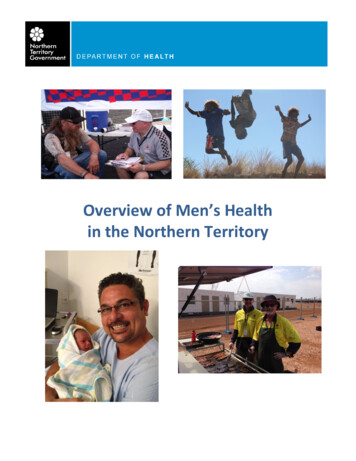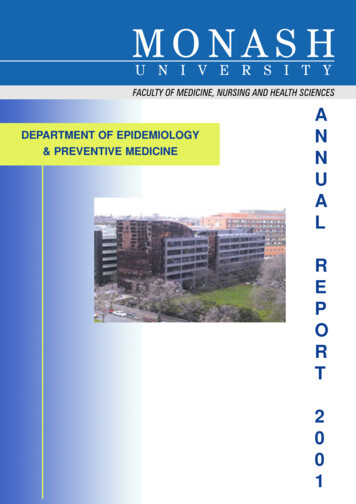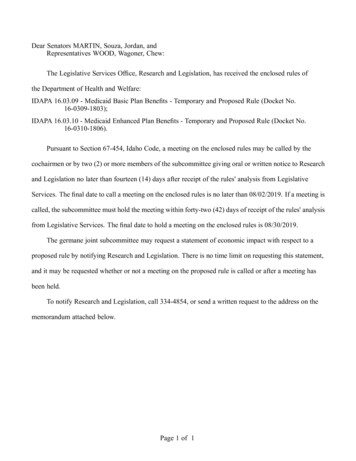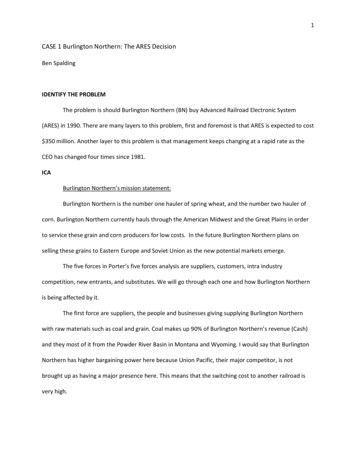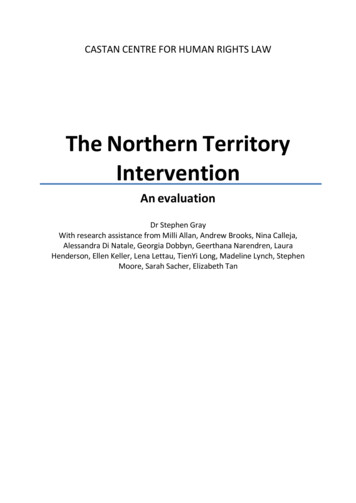
Transcription
CASTAN CENTRE FOR HUMAN RIGHTS LAWThe Northern TerritoryInterventionAn evaluationDr Stephen GrayWith research assistance from Milli Allan, Andrew Brooks, Nina Calleja,Alessandra Di Natale, Georgia Dobbyn, Geerthana Narendren, LauraHenderson, Ellen Keller, Lena Lettau, TienYi Long, Madeline Lynch, StephenMoore, Sarah Sacher, Elizabeth Tan
Table of ContentsWhat is the Northern Territory Intervention?. 2The Intervention in 2007 . 3Changes under successive governments . 42008 Changes . 42012 changes. 52014 changes. 6The Intervention and the Closing the Gap Campaign. 8Issues with Evaluating the Intervention – how did we work out our grades?. 9The Intervention and Closing the Gap targets, have they been reached? . 11Employment and Economic Participation . 11Education . 14Health and Life Expectancy . 17Safer Communities . 20Family Violence and Child Abuse. 20Crime . 22Alcohol and Drugs . 23Lowered Incarceration rates . 25Human Rights and the Intervention . 27Special Measures. 29Racial Discrimination . 31Right to Self-Determination . 32Right to Social and Cultural Rights. 35Right to be consulted . 37Right to Social Security . 38Rights of Children . 39Genocide . 41July 2015
What is the Northern Territory Intervention?The Intervention is the colloquial name for the Northern Territory Emergency Response (NTER). Itis a wide range of complex and controversial measures that have been introduced since August2007, when the Howard Government enacted the Northern Territory National EmergencyResponse Act (NTNERA) with bipartisan support.The Intervention was directed at addressing the disproportionate levels of violence in Indigenouscommunities in the Northern Territory, as well as the endemic disadvantage suffered in terms ofhealth, housing, employment and justice.It was also a direct response to the Ampe Akelyernemane Meke Mekarle Report (‘Little Children areSacred Report’) into sexual abuse of Indigenous children. This report was commissioned by the thenNorthern Territory Chief Minister Clare Martin following an interview on the ABC’s Lateline program,in which Alice Springs Senior Crown Prosecutor Dr Nanette Rogers SC commented that the violenceand sexual abuse of children that was entrenched in Indigenous society was ‘beyond most people’scomprehension and range of human experience’. The then Commonwealth Minister for Families,Community Services and Indigenous Affairs, Mal Brough, indicated in his second reading speechintroducing the NTNERA that “[t]his bill and the other bills introduced in the same package areall about the safety and wellbeing of children.”The Little Children are Sacred Report was the result of in-depth research, investigation andcommunity consultation over a period of over eight months by members of the Northern TerritoryBoard of Inquiry. The focus of their inquiry was instances of sexual abuse, especially of children,in Northern Territory Indigenous communities. The findings were presented to Chief MinisterMartin in April 2007 and released to the public in June. The striking facts, graphic imagery andardent plea for action contained in this report saw this issue gain widespread attention both in themedia and in the political agenda, inciting divisive debate and discussion.The NTNERA was enacted by the Howard Government just two months after the report was releasedto the public, allowing little time for consultation with Indigenous communities. It was framed as a‘national emergency’ with army troops being deployed to Indigenous communities in the NorthernTerritory. This took place in the lead up to the 2007 Federal Election, in which the Labor Partyunder Kevin Rudd defeated the Howard Government after four terms of Liberal government.July 2015
The Intervention in 2007The Intervention was a 587 million package of legislation that made a number of changesaffecting specified Indigenous communities in the Northern Territory. It included restrictions onalcohol, changes to welfare payments, acquisition of parcels of land, education, employment andhealth initiatives, restrictions on pornography and other measures.The package of legislation introduced included: Northern Territory National Emergency Response Act 2007. Social Security and Other Legislation Amendment (Welfare Payment Reform) Bill 2007. Families, Community Services and Indigenous Affairs and Other Legislation Amendment.(Northern Territory National Emergency Response and Other Measures) Act 2007. Appropriation (Northern Territory National Emergency Response) Bill (No. 1) 2007-2008. Appropriation (Northern Territory National Emergency Response) Bill (No. 2) 2007-2008.In order to enact this package of legislation, several existing laws were affected or partiallysuspended, including: Racial Discrimination Act 1975. Aboriginal Land Rights (Northern Territory) Act 1976. Native Title Act 1993(Cth). Northern Territory Self-Government Act and related legislation. Social Security Act 1991. Income Tax Assessment Act 1993.A raft of reforms and regulations were introduced by this package of legislation, including: Restricting the sale, consumption and purchase of alcohol in prescribed areas. This includedthe prohibition of alcohol in certain areas prescribed by the legislation, making collection ofinformation compulsory for purchases over a certain amount and the introduction of newpenalty provisions. ‘Quarantining’ 50% of welfare payments from individuals living in designated communitiesand from beneficiaries who were judged to have neglected their children. Compulsorily acquiring townships held under title provisions of the Native Title Act 1993with the introduction of five year leases in order to give the government unconditionalaccess. Sixty-five Aboriginal communities were compulsorily acquired. Linking income support payments to school attendance for all people living on Aboriginalland, and providing mandatory meals for children at school at parents’ cost.July 2015
Introducing compulsory health checks for all Aboriginal children. Introducing pornography filters on publicly funded computers, and bans on pornography indesignated areas. Abolishing the permit system under the Aboriginal Land Rights Act 1976 for common areas,road corridors and airstrips for prescribed communities,. Increasing policing levels in prescribed communities. Secondments were requested fromother jurisdictions to supplement NT resources. Marshalling local workforces through the work-for-the-dole program to clean-up and repaircommunities. Reforming living arrangements in prescribed communities through introducing market basedrents and normal tenancy arrangements. Commonwealth funding for the provision of community services. Removing customary law and cultural practice considerations from bail applications andsentencing in criminal trials. Abolishing the Community Development Employment Projects (CDEP).Changes under successive governmentsAfter an initial focus on preventing child sexual abuse, successive federal governments re-designedand re-framed the Intervention. This involved linking the Intervention with the broader ‘Closing theGap’ campaign, introducing new measures such as the BasicsCard and tougher penalties for thepossession of alcohol and pornography. Changes were also made to the operation of the RacialDiscrimination Act (see section on Human Rights). The current package of legislation retains thesupport of the Liberal Government and is due to expire in 2022.2008 ChangesThe Intervention was introduced in 2007 by the Howard Government, but a change of governmentin September of that year saw the Labor Government under Kevin Rudd gain power. After someconsultation and minor changes, the NTNERA and associated legislation were initially maintained.In 2008 Rudd apologised to the members of the Stolen Generations on behalf of the nation. In2009, Rudd also declared support for the most substantive framework for the rights of Indigenouspeoples, the UN Declaration on the Rights of Indigenous Peoples. The previous Howard governmenthad voted against the ratification of this treaty. Article 3 of the Declaration states that:‘Indigenous peoples have the right of self-determination. By virtue of that right they freely determinetheir political status and freely pursue their economic, social and cultural development’.The failure to recognise this right to self-determination would become one of the major points ofcriticism for the Intervention.July 2015
In 2009 Rudd implemented the BasicsCard. The card is used to manage income in certain areas ofthe Northern Territory. It cannot be used to purchase alcohol, tobacco, tobacco-products,pornography, gambling products or services, home-brew kits or home-brew concentrate.During the period 2009-2010 the Rudd Government committed itself to a re-design of theIntervention, with a focus on reinstating the suspended provisions of the Racial Discrimination Act(RDA). The Social Security and Other Legislation Amendment (Welfare Reform and Reinstatement ofRacial Discrimination Act) Act 2010 (Cth) repealed the ‘special measures’ that had been createdunder the original Intervention to suspend the operation of the RDA. However, this new legislationstill did not comply with the RDA as it continued to discriminate against Indigenous Australiansthrough land acquisition and compulsory income management.These measures overwhelminglyaffect Indigenous people.The focus of the government then shifted slightly, concentrating more closely on the need to ‘tacklethe destructive, intergenerational cycle of passive welfare’ (see then Minister for Families,Community Services and Indigenous Affairs Jenny Macklin’s second reading speech). The Ruddgovernment explicitly linked the Intervention to the ‘Closing the Gap’ targets, changing thefocus of the Intervention from the protection of children from sexual abuse to the reform of thewelfare system.2012 changesThe legislative basis for the Intervention was due to expire in 2012. Decisions regarding its futurehad to be made. Under the Gillard Government, the Stronger Futures in the Northern Territory Act2012 (Stronger Futures) replaced the NTNERA and extended the Intervention for a further ten yearsto 2022. The Stronger Futures legislation comprises three principal Acts (the Stronger Futurespackage), plus associated delegated legislation. The three Acts are: Stronger Futures in the Northern Territory Act 2012;Stronger Futures in the Northern Territory (Consequential and Transitional Provisions) Act2012; andSocial Security Legislation Amendment Act 2012.In 2013, the Parliamentary Joint Committee on Human Rights examined Stronger Futures and therelated legislation in their 11th Report. They noted that although the Stronger Futures legislativepackage repealed the Northern Territory Emergency Response (‘NTER’) legislation, it retained threekey policy elements: The tackling alcohol abuse measure: the purpose of this measure was 'to enablespecial measures to be taken to reduce alcohol-related harm to Aboriginal people inthe Northern Territory. The land reform measure: the land reform measure enabled the Commonwealth toamend Northern Territory legislation relating to community living areas and townJuly 2015
camps to enable opportunities for private home ownership in town camps and moreflexible long-term leases.The food security measure: the purpose of this measure was 'to enable specialmeasures to be taken for the purpose of promoting food security for Aboriginalcommunities in the Northern Territory’; modifying the legislation involves a 10year timeframe with most provisions other than the alcohol measures beingreviewed after 7 years.The key changes imposed under the 2012 Stronger Futures legislation package consist of: Expansion of income management through the BasicsCard and the increase of ‘quarantined’payments to 70%.Increased penalties related to alcohol and pornography, with as much as 6-months jail timefor a single can of beer.Expansion of policy that links school attendance with continued welfare payments.Introduction of licences for ‘community stores’ to ensure the provisions of healthy, qualityfood.Commonwealth given power to make regulations regarding the use of town camps.{Sources: SBS Factbox, Stronger Futures in the NT, Listening but not Hearing Report}Although consultation with Indigenous communities did take place, there was much criticism of thenature of the consultative process and the extent to which it was acted upon. The ‘Listening butnot Hearing’ report by the Jumbunna Indigenous House of Learning concluded that “theGovernment’s consultation process has fallen short of Australia’s obligation to consult withIndigenous peoples in relation to initiatives that affect them”.The Australian Council of Human Rights Agencies has also stated that it was ‘invasive and limiting ofindividual freedoms and human rights, and require[s] rigorous monitoring’. Amnesty Internationalcommented that the new package of legislation was the same as the original ‘Intervention, but withthe pretence of being non-discriminatory.’2014 changesThe current Intervention legislation is not due to expire until 2022. During his time as OppositionLeader, Tony Abbott supported extending the intervention into the future.In a speech in February of 2014, then Prime Minister Abbott identified the importance of closingthe gap through investment in indigenous programs, with a specific focus on school attendance.However, this speech was followed by massive budget cuts to Aboriginal legal and healthservices, early childhood education and childcare, and the consolidation of 150 Indigenousprograms into 5 core programs. While the 2015 Budget reinstated funding to Family Violencelegal services, these ongoing cuts are expected to detrimentally affect attempts to Close the Gapof Indigenous disadvantage.The 2015 Budget modified the Stronger Futures NPA, redirecting 988.2 million in funds to the newNational Partnership Agreement on Northern Territory Remote Aboriginal Investment (NPA) overeight years. This new NPA prioritises schooling, community safety and employment. This fundingJuly 2015
also aims to help the Northern Territory Government take full responsibility for the delivery ofservices in remote Indigenous communities. Additional funding will also be made available toextend the income management scheme until 2017. However, the new NPA has halved thespending allocated to health measures, and means that the Federal Government will have less controlover target outcomes.Government administered funding of 1.4 billion, previously available under Stronger Futures, willnot be transferred to the new NPA, but will be delivered by the departments of Prime Minister andCabinet and Social Services, outside the NPA framework. The new NPA will be complemented by aRemote Indigenous Housing Strategy that will receive 1.1 billion nationally.July 2015
The Intervention and the Closing the Gap CampaignIn 2008, following the change of government after the 2007 Federal Election, the Rudd LaborGovernment re-framed the Intervention through a new national policy focus on ‘Closing the Gap’.Rudd’s intention to re-work the Intervention to focus more closely on reforming the welfaresystem linked closely with the already existing targets of the Close the Gap Campaign. The aimsof the campaign are set out in the 2012 National Indigenous Reform Agreement.The Council of Australian Governments (COAG) had identified six areas of Indigenous disadvantageto target as the basis for the Closing the Gap Campaign. These were:1) Early childhood;2) Schooling;3) Health;4) Economic Participation;5) Safe Communities; and6) Governance and Leadership (see Right to Self Determination below).The Closing the Gap in the Northern Territory National Partnership Agreement (2009) ceased onthe 30 June 2012. The Stronger Futures in the Northern Territory package which started on 1 July2012 continued to support the Closing the Gap reforms.The 6th Annual Progress Report on Closing the Gap was tabled in Parliament by then Prime MinisterTony Abbott on 12 February 2014. It outlined the commitments made by the Coalition government,including: Consolidating the administration of Indigenous programs from eight governmentdepartments into the Department of the Prime Minister and Cabinet.Establishing the Prime Minister’s Indigenous Advisory Council Increasing indigenous school attendance through providing 28.4 million funding for aremote school attendance program. Improving indigenous access to employment by commissioning a review and fundingemployment initiatives. Supporting a referendum for the recognition of the First Australians in the AustralianConstitution.However, in the seventh annual progress report of 11 February 2015, then PM Tony Abbott labelledprogress as ‘profoundly disappointing’. The report concluded that 4 out of 7 targets were not ontrack to be met by their deadlines, with little progress in literacy and numeracy standards anda decline in employment outcomes since 2008.July 2015
Issues with Evaluating the Intervention – how did we work out our grades?The lack of impartial data available has impacted on the quality of the debate surrounding theIntervention. While a large number of reports have been undertaken, most are commissioned bygovernment. Some reports have been criticised for relying on favourable figures to the exclusionof other data. Significant issues with the quality of statistical data available further impede theability to reliably evaluate the effectiveness of the Intervention.Quantity of Evaluation: The controversial nature of the Intervention and the need for expenditure tobe accounted for has meant that there have been a large number of evaluations undertakenregarding various aspects of the Intervention. Within five years of the establishment of theIntervention, by December 2012, 98 reports, seven parliamentary inquiries and hundreds ofsubmissions had been completed. However, the sheer quantity of these reports actually hinders theevaluation process, as it obstructs proper evaluation of effectiveness.Impartiality of Evaluation: The majority of evaluations of the Intervention have been undertaken bygovernment departments and paid consultants. Australian National University researchers JonAltman and Susie Russell suggest that the evaluation of the Intervention, instead of being anindependent objective process, has been merged into the policy process and, in many cases, isperformed by the policy-makers themselves. This means there is a real risk of evidence beingignored or hidden to suit an agenda.Independent reports and government commissioned reports have often contradicted each other,with the government seeking to discredit independent reports rather than gathering additional data.This includes independent reports by researchers at Jumbunna Indigenous House of Learning at theUniversity of Technology Sydney, Concerned Australians and the Equality Rights Alliance, all ofwhich have often come to different conclusions than government reports.Quality and Consistency of Evaluation: The ‘final evaluation’ of the Intervention under the NTNERoccurred in November 2011 with the publication of the Northern Territory Emergency ResponseEvaluation Report. However, the Stronger Futures legislation did not come into effect until August2012. This left eight months unaccounted for.Closing the Gap in the Northern Territory Monitoring Reports are conducted every six months. Asignificant criticism is that they focus on bureaucratic ‘outputs’ rather than outcomes. Incomemanagement studies, for example, have reported on ‘outputs’ such as the number of recipients ofthe Basics Card or theJuly 2015
total amount of income quarantined, rather than focusing on the card’s effectiveness for health andchild protection outcomes.Much of the data collected has also relied on self-assessment in the form of surveys, such as askingindividuals to rate their own health rather than collecting and analysing data on disease. Anotherissue is the ad hoc nature of some reports. For example, the review of the Alcohol ManagementPlan in Tennant Creek was only conducted once. This makes it difficult to make comparisons overthe life of the policy and evaluate the effectiveness of particular measures.Independent statistical data can be hard to find, since information compiled by the AustralianBureau of Statistics is national in scope and cannot be translated directly into the context of theindividual Indigenous communities in the Northern Territory. Indigenous Australians also have alower median age than other Australians, meaning data on employment rates or incarceration ratescan be statistically skewed.Benchmarks for Evaluation: ANU researchers Jon Altman and Susie Russell have noted that the“absence of an overarching evaluation strategy has resulted in a fragmented and confusedapproach”. They found that the 2007 Intervention did not have any documentation articulating thebasis of the policy, nor how it should be evaluated. The first document to address this was theunpublished Program Logic Options Report which was developed in 2010; three years after theIntervention began. This means that there are no original benchmarks for evaluation, and that thedecision to extend the program in 2012 was made without clear evidence as to its effectiveness.Furthermore, there is a limited connection between the benchmarks proposed in the 2010 Reportand those used in later evaluations.July 2015
The Intervention and Closing the Gap targets, have they been reached?Employment and Economic Participation – 3/10While measurement is difficult, the data that is available suggests that little progress has beenmade on improving employment outcomes in the Northern Territory, and the gap is, in fact,widening.After moving from a focus on protecting children, the employment initiatives introduced under theIntervention were refined and extended. In 2008, the Council of Australian Governments (COAG)introduced the National Integrated Strategy for Closing the Gap as part of a new ‘integratedapproach to employment services’. A number of employment services were brought together,including Job Services Australia (JSA), Indigenous Employment Program (IEP) and CommunityDevelopment Employment Projects (CDEP). However, this package of programs has been criticisedas ‘fragmented’, ‘inflexible’ and ‘unresponsive to community needs’.A specific employment package for the Northern Territory worth 75.4 million was alsoimplemented through Community Employment Brokers, which included work-for-the-dole, jobnetwork services and structured training and employment projects. These reforms aimed topromote economic independence and participation in the economy, as well as skill acquisition andemployer support. It was hoped that in the long term these reforms would engage people in themainstream economy and improve employability and personal responsibility, with flow on effects tofamilies and communities.In July 2009, the CDEP program was discontinued in all non-remote communities and all CDEPparticipants were moved onto income support payments to encourage employment in themainstream economy. Existing participants in remote communities would continue receiving wagesuntil 2011 (later extended to 2017, then cut back to July 2015). Many of the communitydevelopment projects that had been operating were assisting with the psychological traumas passedthrough the generations or providing essential services such as safe houses and communityeducations and activities. In 2012, legislation was enacted to create 50 new jobs and 100traineeships; however the CDEP program had previously employed 7,500 individuals.Remote Jobs and Communities Program (RJCP) was created in 2013 to replace and streamline theexisting programs. It focused on community ownership and skill training in activities that benefitedJuly 2015
the community. ‘Mutual obligation’ activities meant that recipients had to work 15-20 hours perweek in accordance with Individual Participation Plans. From July 1 2015, the RJCP was renamed theCommunity Development Programme and extended to 5 days per week.The Australian Bureau of Statistics has stated that it is difficult to obtain accurate statistics onindigenous communities in the Northern Territory due to small numbers and wide dispersion,especially in remote areas across the territory. The indigenous population also has more youngpeople, which can skew employment figures when compared to non-indigenous populations.The numbers: From 2008-10 there were over 2000 jobs created in the Northern Territory, whichcorresponded with a 9% increase in the number of Indigenous people employed in non-CDEP jobs.But despite the government’s efforts to transition to a reliance on the mainstream economy foremployment, only a third of the Indigenous population held non-CDEP jobs in 2011, compared tofour-fifths of the non-Indigenous population. On top of this, 1357 Indigenous people were employedin service industries directly reliant on the Intervention during 2012-13.The gap between the Indigenous and non-Indigenous unemployment rates throughout the NorthernTerritory have widened slightly, from 10% at the start of the Intervention to more than 11% in 2011.The labour force participation rate for Indigenous Australians in the Northern Territory decreasedbetween 2007-11, which along with increased non-Indigenous participation rates, caused the gap toincrease over 17%. However, this decreased participation may be a result of CDEP programsceasing, which had inflated the pre-2009 ‘employed’ statistics.The income gap between Indigenous Northern Territorians and their non-Indigenous counterpartshas also increased. The median household income of Indigenous households grew at a slower ratethan non-Indigenous households. Likewise, the gap between personal income levels has alsowidened in the Northern Territory, despite narrowing in other states. This indicates that theNorthern Territory-specific policies that have been implemented are actually having a negativeimpact on income levels. As such, the number of people on income support increased significantlyfrom 2009-10 before decreasing slightly from 2011-12.Evaluation: Communities feel that the increase in employment is beneficial. However, thecancellation of the CDEP program and replacement with the RJCP has not been accompanied byadditional job creation in the mainstream economy. The demand for employment in the relevantareas of the Northern Territory has outstripped the number of jobs available, and governmentefforts to provide jobs have been insufficient. This is especially the case in remote communitieswhere there are limited employment opportunities. Where jobs have been created, the governmenthas acknowledged that they are dependent on ongoing funding and provide few avenues for careerprogression or mobility. Community feedback reflects similar concerns. In the 2011 CommunitySafety and Wellbeing Research Survey, most Indigenous respondents commented that moreemployment and training opportunities were needed.The fly-in, fly-out model of the Community Emplo
Marshalling local workforces through the work-for-the-dole program to clean-up and repair communities. Reforming living arrangements in prescribed communities through introducing market based rents and normal tenancy arrangements. Commonwealth funding for the provision of community services.


